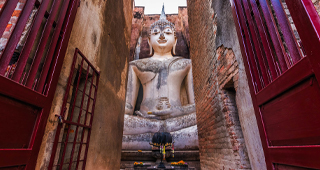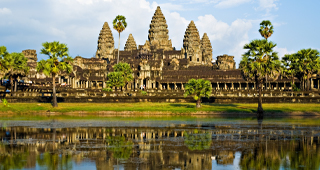Book NOW for $1 £1 €1 • Flexible Payments • No Change Fees • Private Departures Available
- Home >>
- Chiang Mai City Guide
Chiang Mai City Guide
Perhaps the most well known city in Thailand outside of Bangkok, a trip to Chiang Mai makes it abundantly clear as to why. Founded during the 13th century, the colourful history immediately becomes palpable the moment you cross the ancient moat and enter the walled old city. Every other street seems to have a temple that is more unfeasibly beautiful than those that preceded it and every one of the historical backstreets resonate with the same engaging spirituality of Thailand’s most ancient pagodas. Much of Chiang Mai’s beauty lies in its surroundings. Rolling hills of verdant green and delicately meandering rivers paint the landscape as far as the eye can see. Untouched local communities and remote religious sites possessing an ethereal tranquility are often waiting to be discovered on their emerald slopes. Chiang Mai is also the best place to sample Northern Thailand’s greatest delicacies. The air of the old city’s bustling streets is swimming with the tantalising flavours of richly spiced dishes that are sure to tempt the tastebuds of anyone that crosses their path. Chiang Mai is a true treat for the senses.
Chiang Mai’s Best Spots
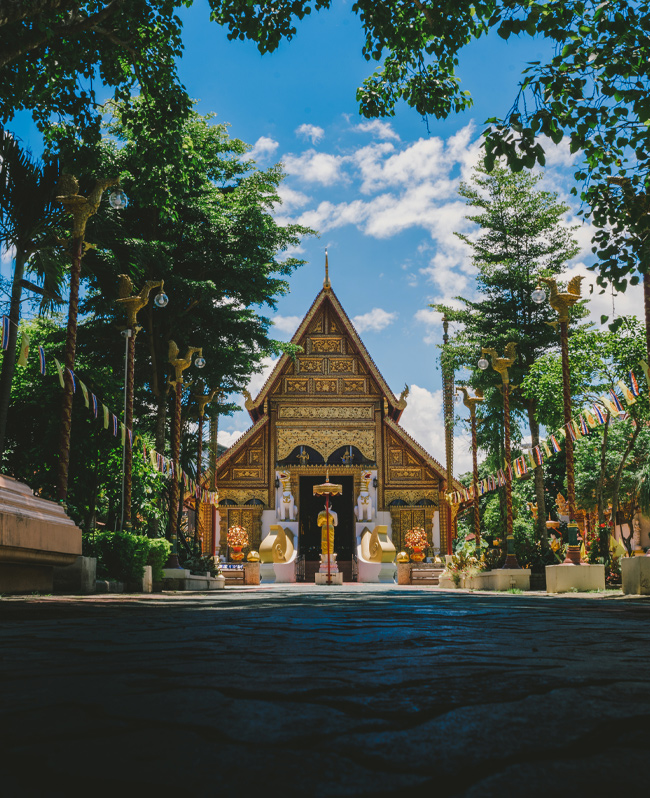
The majority of any traveller’s time in the city of Chiang Mai will likely be spent within the walls of the old city. Exploring the network of streets that wind through the area will introduce travellers to the ever-impressive Buddhist structures that act as the cultural foundation of the city. Amongst the most impressive is Wat Phra Singh, or Gold Temple, which is home to a number of structures that possess a quintessentially Thai intricacy in their designs. The complex also accommodates 700 monks who are typically more than happy to chat with interested travellers. Right at the centre of the old city are the charismatic ruins of Wat Chedi Luang, whose ancient stone walls were once home to Thailand’s holiest relic, the Emerald Buddha, before the temple was toppled by an earthquake in 1545. The ruins are still used by local monks to this day, offering a chance to witness a poetic blend of bygone and contemporary Buddhist traditions.
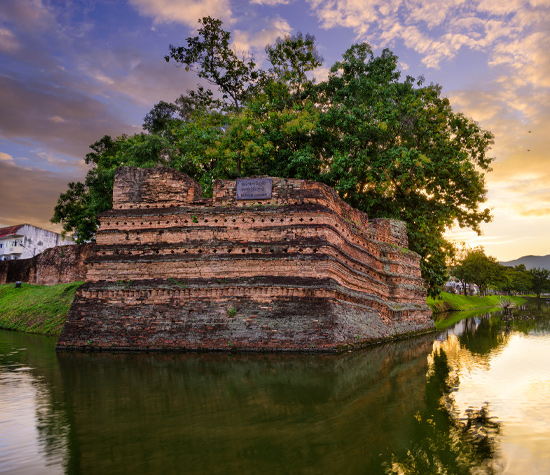
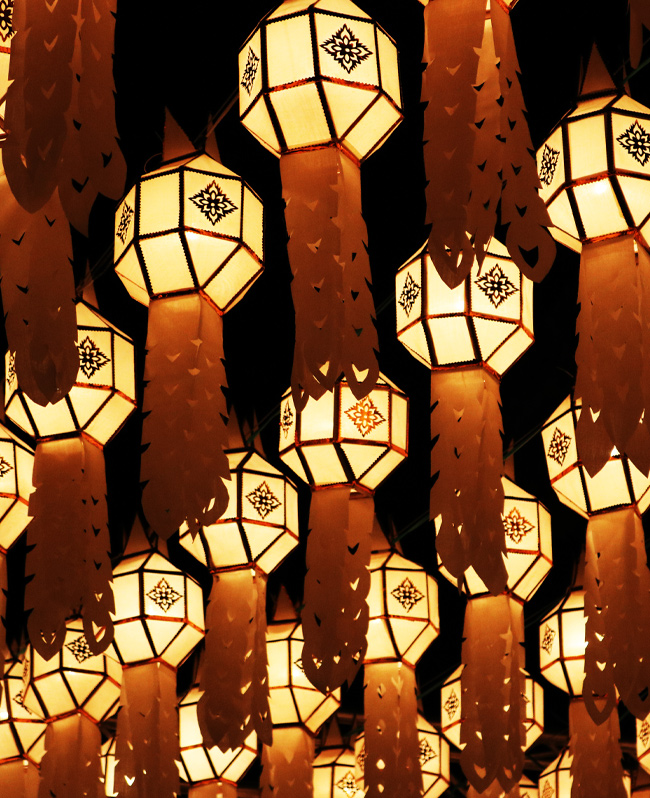
As well as being home to most of the cityl’s greatest temples, Chiang Mai’s old city is known for its excellent food scene and energetic nightlife. Tempting smells fill the air from lunchtime onwards and once the sun sets, the city shifts in character from spiritual haven to lively social hub. The eastern end of the old city in particular is home to a number of popular drinking spots, from glitzy cocktail bars to ramshackle vendors with more of a local charm. Ratchadamnoen Road becomes a hub of activity on Sunday evenings with the opening of the Weekend Market, which sees revellers fill the streets in search of handmade goods and delectable bites to eat.
Outside the old city there are markets aplenty. To the east is the Night Bazaar, a collection of indoor stalls that attracts both locals and travellers to its bustling avenues every evening. North of the Night Bazaar is Warorot Market, the oldest market in the city, famous for its stalls specialising in fresh food and filling street eats. Those in search of a shopping experience of more modern and epic proportions should seek out the boutique streets surrounding Nimman Road to the west of the old city. The area has gained a reputation as the place to find Chiang Mai’s most fashionably high end establishments, from restaurants to shops to hotels.
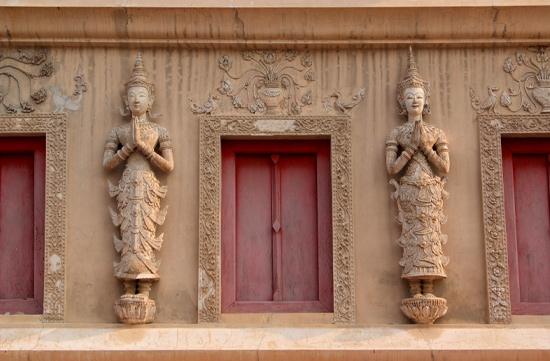
Trips that visit Chiang Mai
Laos & Thailand Highlights
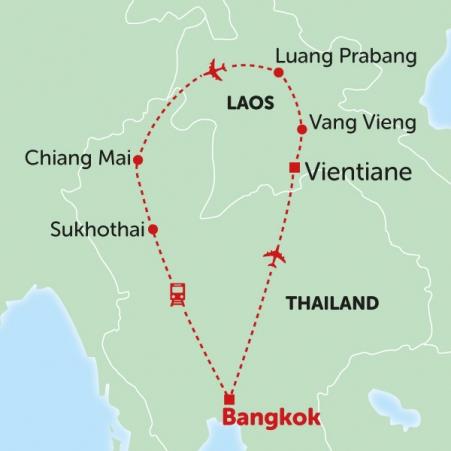
Duration:15 Days
Route:Bangkok to Bangkok
Tour Code:ICLT
Vietnam, Laos & Thailand Express
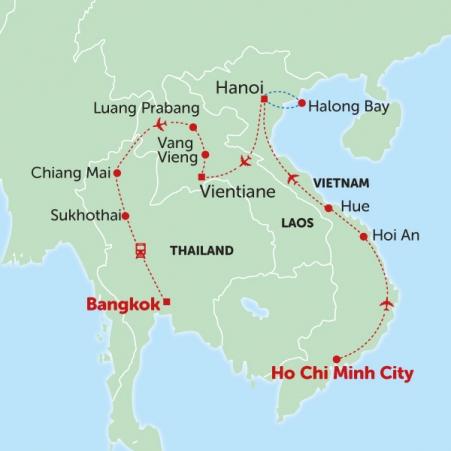
Duration:22 Days
Route:Ho Chi Minh City to Bangkok
Tour Code:ICVL
Food in Chiang Mai
Chiang Mai is a veritable hub of delicious eateries that rival the succulent flavours of anything that is served on the streets of Bangkok. Whether is be amongst the hustle and bustle of a vibrant night market or sat on a roadside plastic stool outside a friendly local cafe, the quality of food that is conjured up by the local masters of flavour almost justify a trip to Chiang Mai by themselves. All the classic Thai dishes can be found here but there are certain recipes that must be sampled when in Chiang Mai.
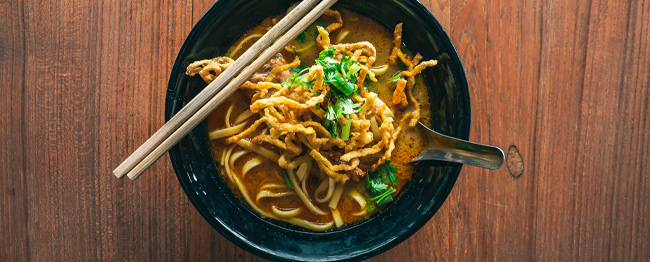
One dish that is sold by most food vendors in the city is the northern speciality khao soi. Delicate egg noodles sit in a lightly spiced aromatic coconut broth alongside succulent meat before being topped with a mix of fragrant herbs and a sprinkle of noodles that have been lightly fried until crispy and golden. Street stalls can also often be seen selling khao kha moo, which roughly translates as ‘stewed pork leg with rice’ - a very succinct summary of the meal’s main components. The expertly braised leg of pork falls apart when touched, such is its tenderness. Combine this with fluffy rice and a marinade of typically thai flavouring and you have one of the greatest dishes that can be found in the country’s northern regions. Those with a higher spice tolerance may also opt for a portion of laab, which consists of minced meat or mushrooms simmered with coriander, mint, lime juice and lashings of chilli.
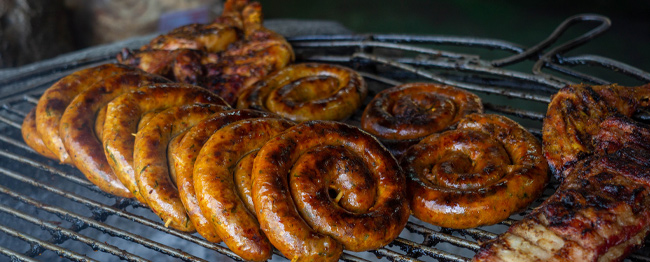
One of Northern Thailand’s greatest delicacies is also one of its less conventional. Sai ua is a Thai style sausage that travellers are sure to encounter when wandering amongst the food stalls of Chiang Mai’s markets. Whilst it is close in resemblance to a typical sausage, sai ua is in fact spiced with coriander, lime, lemongrass, ginger and chilli, providing a delightfully delicious Thai twist on a western staple.
Those with a sweeter tooth may opt for the enticingly sweet flavours of mango sticky rice, a dish of sliced mango served on top of classic Thai sticky rice and coated in a drizzle of sweet coconut sauce. The dish manages to morph what is typically a savoury side into the perfect dessert accompaniment.
Getting around Chiang Mai
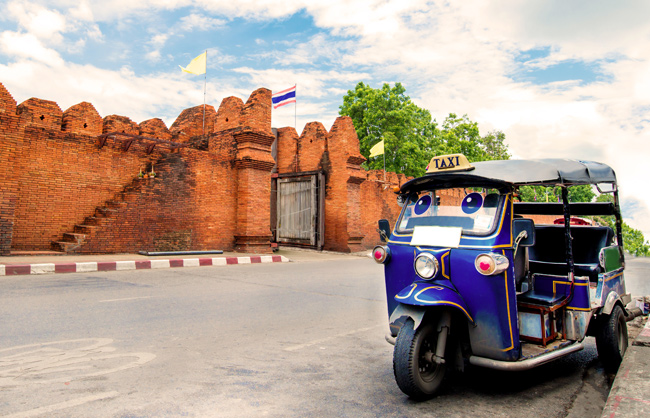
The old city is roughly 1.5km squared, making any trip within its walls very much walkable. Those wishing to travel further afield can opt to travel by either tuk-tuk or songthaew. The former is a vehicle well known to anyone who has travelled in Asia before - three wheeled motorised rickshaws that whizz about the city streets in search of paying customers. Tuk-tuks are quick, efficient and easy to find but are prone to overcharging unknowing tourists. Conversely travellers can opt to travel in one of Chiang Mai’s iconic songthaews, or ‘red trucks’. These rickety, charismatic trucks are equipped with two opposing rows of seats and dont stop anywhere in particular but instead voyage in a general direction, picking passengers up en route. Simply confirm that the truck is going near your destination, hop on and chat to your fellow passengers as you trundle through the city’s streets.
Another popular form of travel amongst tourists visiting Chiang Mai is motorbike. Due to their popularity, motorbike rentals are easy to locate but are inadvisable for anyone with no prior experience. Often travellers believe they’ll be ok as it is ‘the done thing’. This is often not the case. If you do choose to rent a motorbike be sure to wear a helmet at all times.
Alternative things to do in and around Chiang Mai
Given its historical significance, mountainous surroundings and popularity amongst tourists, the activities available in the Chiang Mai area are as varied as they are entertaining. Whether you want to be absorbed into the electric atmosphere of a raucous gathering of locals, sample a cultural experience that can be deemed truly unique or escape from the urban chaos in search of a peaceful highland oasis, Chiang Mai is sure to satisfy all such desires. Adrenaline junkies and culture vultures alike are sure to find what their heart desires.
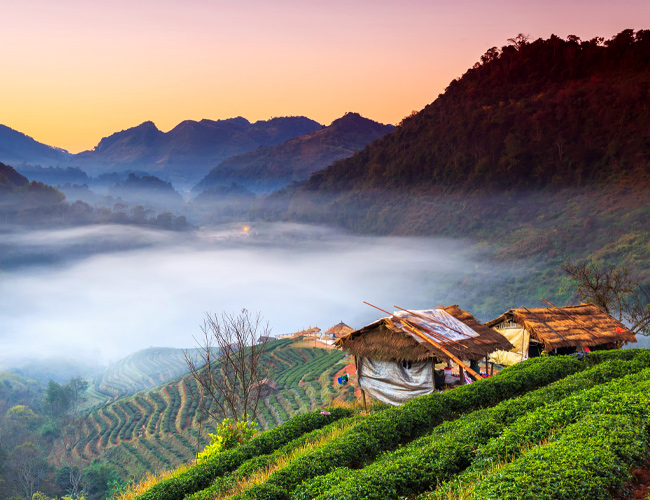
Hiking in the mountainous surroundings
One of the most popular things to do in Chiang Mai is to in fact leave the city to explore the vast expanse of emerald hills that surround its limits. One day treks to Buddhist sites with an epic tranquility. Overnight adventures to regions of untamed natural beauty. All encompassing quests into the wilderness that last for as long as your adventurous spirit desires. The terrain surrounding Chiang Mai covers it all.
Amongst the most popular destinations on these hikes are the temples of Doi Suthep and Wat Pha Lat. Both located within 15km of the city’s western border, there is a magical sense of wonder as you pass through the incessant shrubs and low hanging vines of a dense jungle thicket to have an entire temple complex revealed in front of you. The former’s pristine golden pagoda and spectacularly detailed temples are a must-see experience for anyone that visits Chiang Mai. A particularly magnificent experience if travellers approach by hiking via the Monk’s Trail. The latter is less renowned but the manner in which it has adopted its jungle surroundings, merging the natural and the man made, is fascinating.
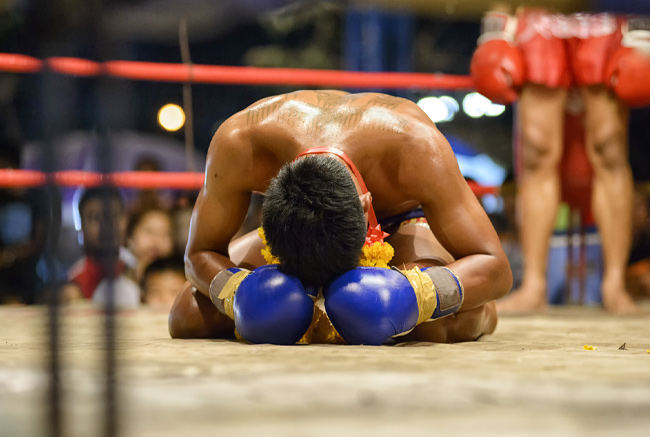
Watching a brutal bout of Muay Thai
A national sport steeped in tradition, Muay Thai is said to have originated as a form of combat taught to soldiers back in the Middle Ages when Thailand was known as Siam. A brutal form of combat where fighters use fists, elbows and knees to try and beat their opponent into submission, it is almost unanimously popular amongst the entirety of Thailand’s population. This passionate popularity becomes evident when attending a bout.
Whilst Bangkok is typically regarded as the home of Muay Thai, the quality of fights in Chiang Mai make sure it is still very much worth watching. If not for the fight then for the crowd’s palpable passion for the sport. Not only is it an adrenaline pumping spectator sport but also a deeply traditional martial art. Fights start with a ritualistic dance and Thai music plays throughout, keeping tempo with the fighters as they seek to outwit and outmuscle their opponent. The creatively named Chiang Mai Boxing Stadium and centrally located Thaphae Boxing Stadium are amongst the most popular arenas in which to watch a bout of Muay Thai.
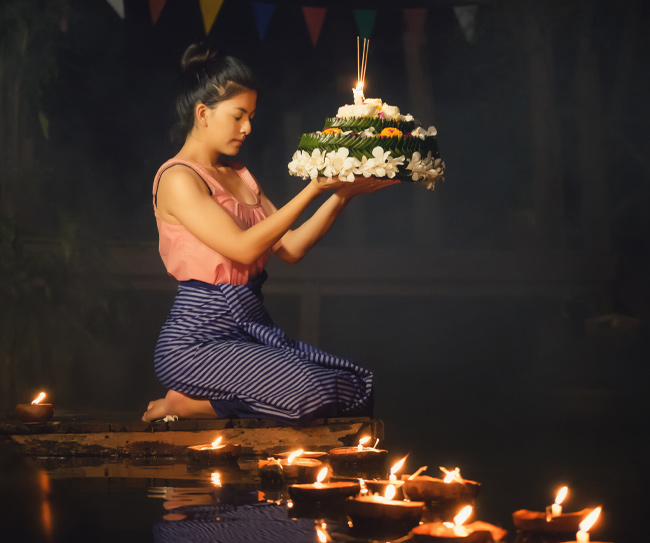
Participating in one of Chiang Mai’s famous festivals
Thailand is a country that takes its festivities seriously. Every notable date in the calendar is met with an explosion of vibrant colour, crowds of joyous locals and celebrations that are sure to last long into the night. Being the second largest city in Thailand after Bangkok, Chiang Mai is an excellent place to embrace the madness of these festivals and celebrate like a local.
Amongst the most popular festivals in Thailand, Songkran is a celebration of the Thai new year that occurs between April 13th and 15th with one of the planet’s most unique celebrations, in the form of a nation wide water fight. Representing a fresh start to the new year, the atmosphere in Chiang Mai during Songkran is regarded as the best in the whole country. The entirety of the old city becomes an aquatic battleground, with all locals and tourists armed to the teeth with water guns, buckets and hoses, ready to soak anyone that crosses their path.
For a more peaceful celebration, travel to Chiang Mai at the end of the rainy season to experience the lantern festival of Loi Krathong. In a symbolic of respect for local spirits, locals release candles down rivers and into the sky, dotting the city’s skyline and waterways with pockets of warm, resplendent light that inspires a calm and happiness in all who witness it.
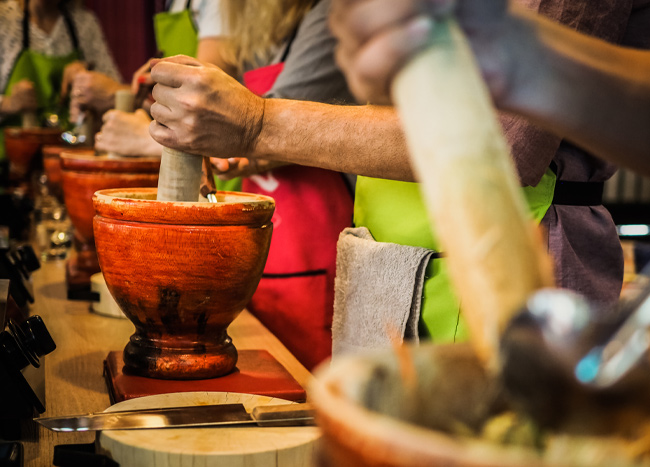
Learning some of Thailand’s greatest recipes in a cooking class
In a nation that is known for its delicious culinary scene, learning to capture even a snippet of what makes the food so delicious is an opportunity that is too good to pass up. The cooking classes available in Chiang Mai are typically very hands on experiences, where attendees are led through local markets to gather the freshest ingredients before choosing the dishes that they wish to learn.
Normarily group sizes are small, meaning budding chefs receive a more personal experience from their teachers, picking up tips that will take your Thai green curry to the next level. Cooking classes are also a brilliant way to meet like minded travellers and have fun whilst you learn skills that are a brilliant alternative souvenir to take home with you.
If you are planning to personalise your own Tailor-made tour, be sure to contact the Tailor-made Team to enquire about the inclusion of a cooking class in your experience.
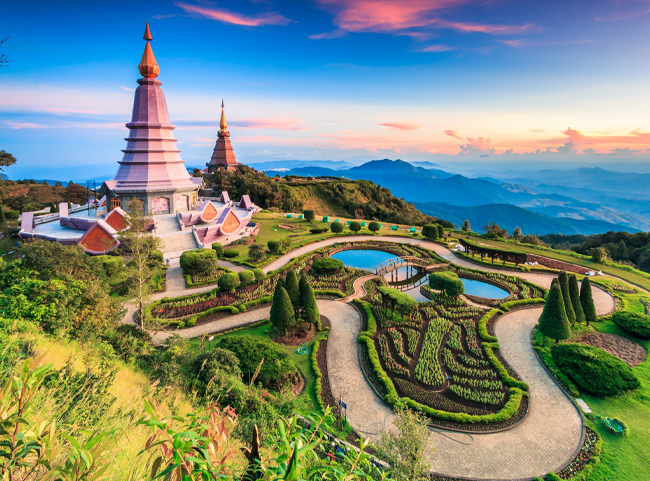
Visiting the heights of Doi Inthanon National Park
The country’s highest peak and arguably the area of greatest natural beauty in the vicinity of Chaing Mai’s historic streets, Doi Inthanon rises 2565m above sea level, earning it the nickname of ‘The Roof of Thailand’. The 1000sq kilometre National Park that surrounds the granite mountain is lush with thick, green jungle that often proves impenetrable. Hidden under the dense blanket of wilderness, visitors can find waterfalls, hiking trails and some of Asia’s most colourful wild inhabitants.
The cool air around the highlands of Doi Inthanon National Park is often utilised by locals as an escape from the heat that can prove unbearable during the height of the region’s hot season. Impeccable views from the summit are sure to take your breath away whilst the route to the top takes travellers past a quaint stupa complex with beautifully maintained gardens overlooking the rolling hills below. Lucky visitors may wish to visit the summit if here during the coldest months in an attempt to see one of the rarest phenomena in Thailand’s tropical territory - frost.
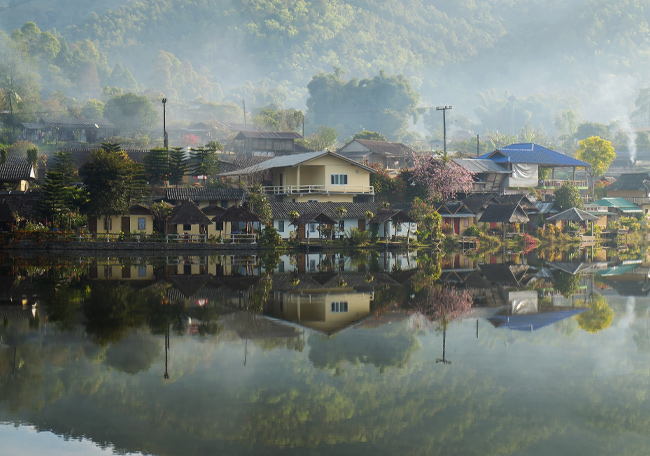
Travelling to the hippy haven of Pai
Two hours north of Chiang Mai, towards the Burmese border along roads that snake through the region’s mountainsides is the village of Pai. Like a small mountain refuge, the village seems cut off from society and immerses its visitors into the plethora of natural beauty that surrounds it. Waterfalls. Mountains. Canyons. Rustic villages. The array of adventurous locations is too tempting to resist.
The village itself became a popular stomping ground for hippies during an era when Thailand was becoming more targeted by adventurous tourists. Thanks to this, the village became a popular hotspot for expats over time. Whilst it may have detracted from the village’s authenticity, it has also adopted a laid back, bohemian feel to it that welcomes travellers with open arms. The streets are home to a number of bars, restaurants and massage parlours that are sure to satiate your needs after a long day of exploration. Whilst it can be visited in a day, Pai is better appreciated if you can stay for the night. A word of warning - the journey to Pai includes 762 turns in the road. Perhaps not one for those with weak stomachs.
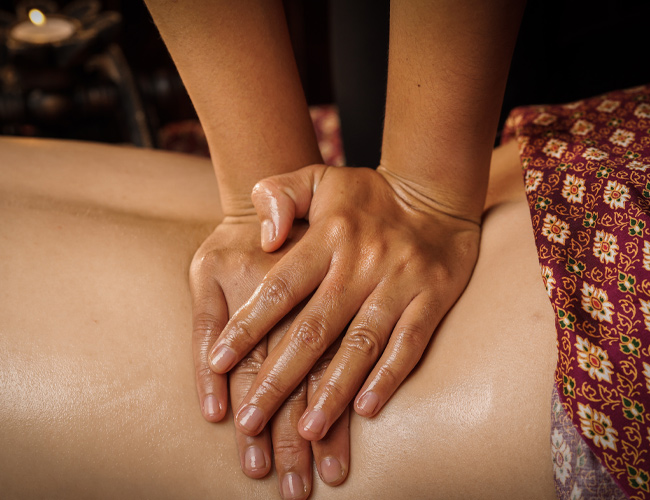
Receiving a massage from a prison inmate
A relaxing massage and a convicted criminal aren't two components that would typically be associated with each other. That said, the Women’s Correctional Institute in Chiang Mai is an excellent institution which strives to create a better life for Thai women who have been incarcerated. The system offers inmates educational services and even allows children up to the age of five stay in the institution with their mothers to avoid emotional distress from separation. One of the educational opportunities available comes in the form of learning Thai massage techniques.
Visitors will enter the prison before being massaged by one of the inmates in an experience that creates a strange sensation of simultaneous blissful relaxation and edgy suspense. A portion of the money paid for the unique service goes towards efforts to reintegrate inmates into society. It is an experience that will leave you both relaxed and with a sense of fulfillment. An alternative way to support the brilliant work of the Women’s Correctional Institute is by attending the restaurant also run by inmates. The food is delicious and again some of your proceeds go towards a noble cause.
Southeast Asia Tailor-made Holidays
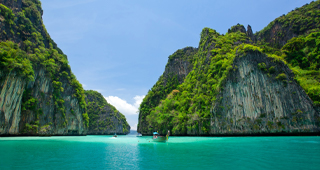
Highlights of Indochina
Duration:19 Days
Route:Phnom Penh to Luang Prabang
Tour Code:TCVL
Thailand Blogs
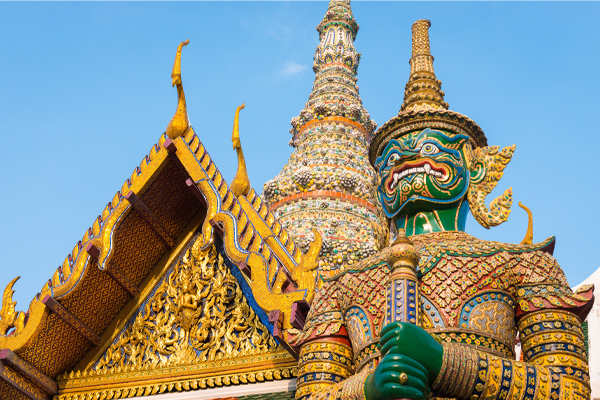
Top attractions in Bangkok
The city of Bangkok is a whirlwind of adventure. The minute you step off the plane, the subtropical southeast Asian heat will encompass you and the sounds and smells will leave you confused as to which direction to head in. While Bangkok is often used as a gateway to other countries in Southeast Asia, the city has plenty of attractions to keep you occupied for a few days. Here are our highlights of Bangkok.
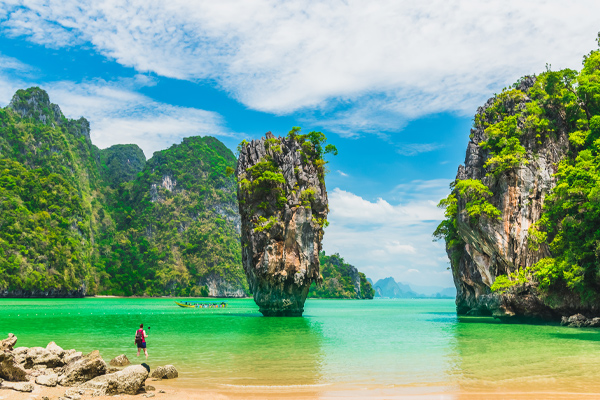
7 Best things to do in Thailand
Tropical Thailand has thick jungle and stunning beaches as well as unmissable heritage sites. Here’s a round-up of our favourite places to visit if you are planning a trip to this magical kingdom.




